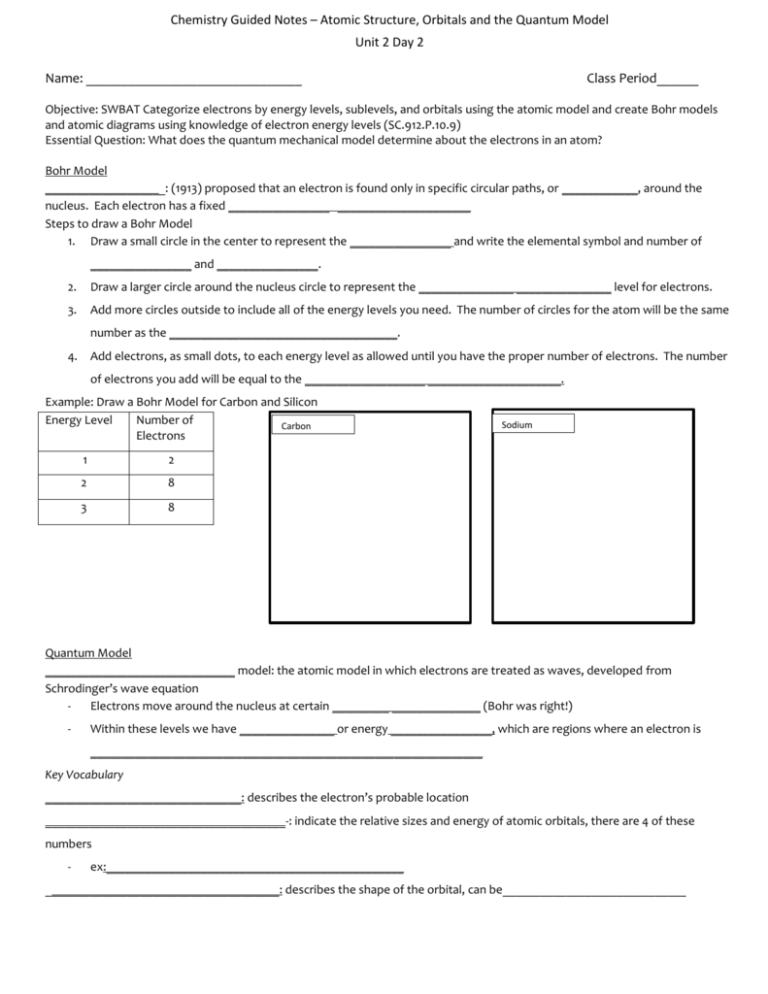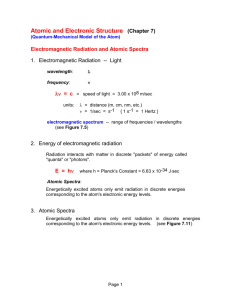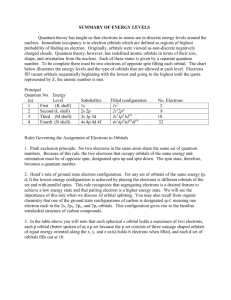Chemistry Guided Notes * Atomic Structure
advertisement

Chemistry Guided Notes – Atomic Structure, Orbitals and the Quantum Model Unit 2 Day 2 Name: _______________________________ Class Period______ Objective: SWBAT Categorize electrons by energy levels, sublevels, and orbitals using the atomic model and create Bohr models and atomic diagrams using knowledge of electron energy levels (SC.912.P.10.9) Essential Question: What does the quantum mechanical model determine about the electrons in an atom? Bohr Model ___________________: (1913) proposed that an electron is found only in specific circular paths, or ____________, around the nucleus. Each electron has a fixed ________________ _____________________ Steps to draw a Bohr Model 1. Draw a small circle in the center to represent the ________________ and write the elemental symbol and number of ________________ and ________________. 2. Draw a larger circle around the nucleus circle to represent the _______________ _______________ level for electrons. 3. Add more circles outside to include all of the energy levels you need. The number of circles for the atom will be the same number as the ____________________________________. 4. Add electrons, as small dots, to each energy level as allowed until you have the proper number of electrons. The number of electrons you add will be equal to the ___________________ _____________________. Example: Draw a Bohr Model for Carbon and Silicon Energy Level Number of Carbon Electrons 1 2 2 8 3 8 Sodium Quantum Model ______________________________ model: the atomic model in which electrons are treated as waves, developed from Schrodinger’s wave equation Electrons move around the nucleus at certain _________ ______________ (Bohr was right!) - Within these levels we have _______________ or energy ________________, which are regions where an electron is ______________________________________________________________ Key Vocabulary _______________________________: describes the electron’s probable location ______________________________________-: indicate the relative sizes and energy of atomic orbitals, there are 4 of these numbers - ex:_______________________________________________ _____________________________________: describes the shape of the orbital, can be_____________________________ Chemistry Guided Notes – Atomic Structure, Orbitals and the Quantum Model Unit 2 Day 2 Orbitals: Each orbital corresponds to a different ______________________ S orbital 1 orbital p orbitals 3 orbitals d orbitals 5 orbitals Summary of Principal Energy Levels and Sublevels Principal Energy Level Number of Sublevels f orbitals 7 orbitals Type of Sublevel Maximum number of electrons n=1 2 3s (1 orbital), 3p (3 orbitals), 3d (5 orbitals) 4s (1 orbital), 4p (3 orbitals), 32 4d (5 orbitals), 4f (7orbitals) Example: Carbon Quantum Model 1. What is the energy level for carbon? ___________________________________________________________ 2. What sublevels are contained in the carbon atom? ________________________________________________ 3. What orbitals are related to each of these sublevels? ______________________________________________ 4. How many electrons are in each orbital and sublevel?______________________________________________ 5. Fill in the table below for Carbon: Principal Sublevels Energy Corresponding Number Number of Orbitals of Level 1 s orbital 2 s orbital Electrons n=1 1s ___________________ 2 n=2 ______ 1 orbital ________ 2p ________________ 2 2p orbital Independent Practice Complete the following book problems on a separate sheet of paper: p.132 #1, 2, 3, 6 and 7; p. 152 #32, 33, 34, 37, 38 Homework: 1. Draw the orbitals for n = 1,2 and 3 and write how many electrons can be in that energy level 1. Draw the Bohr model for oxygen, sodium and silicon







